In interior design, the fusion of historical charm with modern aesthetics has become an increasingly popular trend. Among the many elements contributing to this blend, coving is a timeless feature that adds elegance and character to any space.
From the Victorian era, which spanned from the 1830s to the early 1900s, coving refers to the decorative moulding that adorns the junction between walls and ceilings. While Victorian architecture may evoke images of opulent mansions and grandiose estates, incorporating Victorian coving into contemporary interiors offers a sophisticated way to infuse heritage into modern living spaces.
This comprehensive guide will explore the art of seamlessly integrating Victorian coving into contemporary design schemes.
Understanding Victorian Coving
Before delving into the integration process, it’s essential to grasp the essence of Victorian coving. Ornate details, intricate patterns, and a penchant for elegance characterise Victorian design. Coving was pivotal in Victorian interiors, serving aesthetic and practical purposes. Beyond its decorative appeal, coving was often employed to conceal imperfections in the joint between walls and ceilings, providing a seamless transition between the two surfaces.
Victorian coving typically features elaborate motifs such as floral patterns, scrolls, and geometric designs crafted from plaster or wood. These intricate details reflect the craftsmanship and attention to detail that defined the Victorian era. While traditional Victorian coving may evoke a sense of nostalgia, its versatility allows it to adapt to contemporary settings quickly.
Incorporating Victorian Coving in Contemporary Interiors
Choose the Right Style
Selecting the appropriate style of Victorian coving ensures harmony within your contemporary space. While ornate designs are synonymous with the Victorian era, opting for simpler, more streamlined coving profiles can offer a modern twist. Look for coving with clean lines and subtle embellishments that complement the existing design elements in your interior.
Consider Scale and Proportion
Pay attention to the scale and proportion of the coving about the room. You can opt for more elaborate coving designs in larger spaces with high ceilings to make a bold statement. Conversely, in smaller rooms or spaces with lower ceilings, choosing narrower coving profiles will prevent the room from feeling overwhelmed.
Blend with Existing Architecture
Integrate Victorian coving seamlessly with your home’s existing architectural features. Consider the overall style and period of the property to ensure cohesion between the coving and other design elements. Incorporating elements such as ceiling roses, dado rails, and skirting boards can further enhance the Victorian aesthetic while maintaining a contemporary sensibility.
Experiment with Finishes
Modern manufacturing techniques offer a wide range of finishes for Victorian coving, allowing you to customise the look to suit your preferences. While traditional plaster coving exudes authenticity, lightweight materials such as polyurethane or polystyrene offer practical advantages without compromising aesthetics. Experiment with paint finishes to achieve the desired effect, whether classic matte white or a bold contrasting colour.
Create Contrast
Use Victorian coving to create visual interest and contrast within your contemporary interior. Contrast can be achieved through colour, texture, or even juxtaposing styles. For instance, pairing ornate coving with sleek, minimalist furnishings can create a striking focal point highlighting the beauty of traditional and modern design elements.
Embrace Eclecticism
Mix and match different design styles to create a unique and eclectic interior. Victorian coving can seamlessly coexist with mid-century modern, industrial, or Scandinavian influences, adding depth and character to the space. Experiment with eclectic furniture pieces, artwork, and accessories to strike a balance between old and new.
Highlight Architectural Features
Use Victorian coving strategically to accentuate architectural features such as alcoves, bay windows, or fireplace surrounds. By framing these elements with coving, you draw attention to their inherent beauty while adding a touch of refinement to the overall design scheme.
Customisation and Adaptation
While traditional Victorian coving designs are readily available, consider customising or adapting them to suit your specific design vision. Work with skilled artisans or utilise modern fabrication techniques to create bespoke coving designs that align with the aesthetic of your space. Whether it involves modifying existing patterns, incorporating personalised motifs, or experimenting with unconventional materials, customisation allows you to infuse your unique personality into the design while maintaining the essence of Victorian elegance.
Layering and Dimension
Explore layering to add depth and dimension to your interior space. To create visual interest and complexity, victorian coving can be layered with other architectural elements such as panelling, wainscoting, or ceiling medallions.
Experiment with different combinations of textures, shapes, and depths to achieve a multi-dimensional effect that enhances the overall design scheme. By layering Victorian coving with complementary elements, you create a dynamic interplay of light and shadow, adding richness and depth to the space.
Lighting Integration
Integrate lighting elements with Victorian coving to enhance its decorative impact and create a warm, inviting ambience. Consider incorporating concealed LED lighting within the coving recess or installing wall sconces or picture lights above the coving to illuminate the intricate details and cast a soft, diffused glow across the ceiling.
By strategically positioning lighting fixtures, you highlight the architectural features and create a captivating focal point that enhances the overall atmosphere of the room.
Functional Adaptation
Beyond its decorative function, Victorian coving can be adapted for practical purposes in contemporary interiors. Concealed within the coving profile, wiring and cables for audio-visual systems, lighting, or HVAC components can be discreetly routed, minimising visual clutter and optimising space utilisation.
Additionally, integrating coving with built-in storage solutions such as bookshelves or display cabinets allows for seamless integration of functionality with aesthetics, enhancing the space’s efficiency and versatility.
Continuity and Flow
Extending Victorian coving throughout interconnected spaces maintains continuity and flow between rooms. Consistency in coving profiles, finishes, and installation height ensures a cohesive design narrative unifying the interior environment.
Transition seamlessly from one area to another while preserving the Victorian coving’s timeless elegance and architectural integrity, creating a sense of harmony and coherence that enhances the overall spatial experience.
Heritage Preservation
Embrace the historical significance of Victorian coving by incorporating salvaged or reclaimed pieces into your contemporary interior. Salvage yards, architectural salvage shops, and online marketplaces offer a treasure trove of authentic Victorian coving and architectural elements with a sense of heritage and craftsmanship.
By repurposing these pieces, you contribute to sustainability efforts and infuse your space with a sense of history and nostalgia that adds depth and character to the design.
Final Thoughts
Incorporating Victorian coving into contemporary interiors transcends mere decoration; it embodies a nuanced appreciation for craftsmanship, heritage, and timeless design principles. By embracing customisation, layering, lighting integration, functional adaptation, continuity, and heritage preservation, you elevate Victorian coving beyond its traditional role into a versatile and dynamic design element that enriches the spatial experience.
Whether through bespoke fabrication, innovative lighting solutions, or the integration of salvaged pieces, let Victorian coving symbolise your commitment to bridging the gap between past and present, tradition and innovation, in the ever-evolving interior design landscape.
Write and Win: Participate in Creative writing Contest & International Essay Contest and win fabulous prizes.

















